The Great Dob Mod
By Ed Ting
Updated 6/30/07
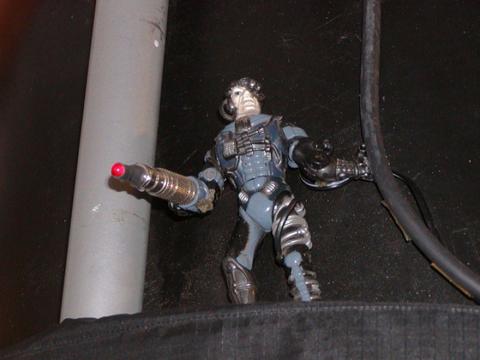 What's A Borg Doing On a Telescope? Read On!
What's A Borg Doing On a Telescope? Read On!
It usually starts with a simple decision – drill a hole, add some flocking material, replace a focuser. Many of
us modify our telescopes to some degree, but can you take this too far? Club member Roger Greenwood doesn’t
think so. When he purchased his 18” Dobsonian reflector from Obsession Telescopes a few years ago, he saw
the scope ripe with possibilities. Roger views a Dob the way Picasso probably viewed a blank canvas. It's a
template for his imagination.
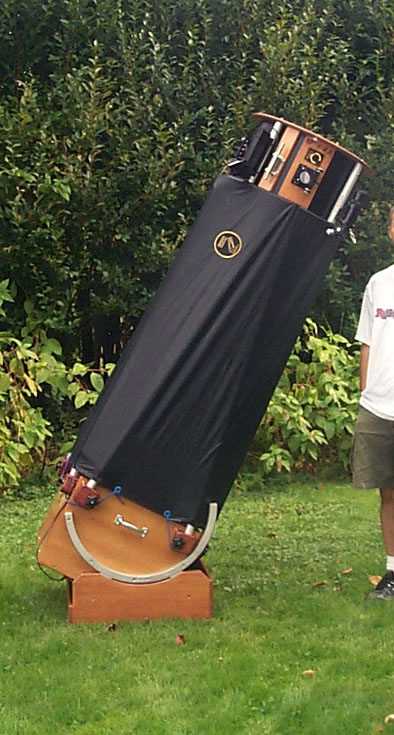 Photo of Stock 18" Obsession
His first modification was simple enough – the addition of a Celestron 8X50 finder to the upper truss pole. He admits
that drilling those first holes were difficult. He got over it, however, and soon added a filter slide assembly inside
the upper truss to simplify the changing of filters. Gradually he began to think of other things he could do to his
scope, and the result today is a telescope known to local club members as the the “Borg” scope (it's slowly becoming
assimilated.)
Photo of Stock 18" Obsession
His first modification was simple enough – the addition of a Celestron 8X50 finder to the upper truss pole. He admits
that drilling those first holes were difficult. He got over it, however, and soon added a filter slide assembly inside
the upper truss to simplify the changing of filters. Gradually he began to think of other things he could do to his
scope, and the result today is a telescope known to local club members as the the “Borg” scope (it's slowly becoming
assimilated.)
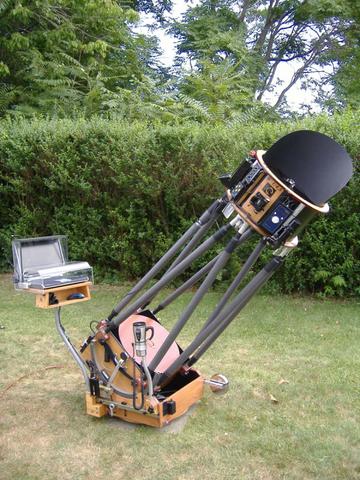 Photo of Modified Telescope
As you can see, significant work has been done to the telescope. Starting with the upper truss, the eight lighted toggle
switches function as a control center for the rest of the scope. From here, the user can select which circuits to use.
These include dew heaters, marker lights, and other functions. The upper truss also houses a Telrad, the 8X50 finder
scope mentioned earlier, dew heater distribution box, slewing controls, and the Argo Navis head unit.
Dual readouts (also illuminated) show the current voltage and current outputs from the battery pack (see below). Since the
scope is tethered to the power pack, which may be sitting far away, it is nice to have current and voltage readouts handy
on the scope itself.
Photo of Modified Telescope
As you can see, significant work has been done to the telescope. Starting with the upper truss, the eight lighted toggle
switches function as a control center for the rest of the scope. From here, the user can select which circuits to use.
These include dew heaters, marker lights, and other functions. The upper truss also houses a Telrad, the 8X50 finder
scope mentioned earlier, dew heater distribution box, slewing controls, and the Argo Navis head unit.
Dual readouts (also illuminated) show the current voltage and current outputs from the battery pack (see below). Since the
scope is tethered to the power pack, which may be sitting far away, it is nice to have current and voltage readouts handy
on the scope itself.
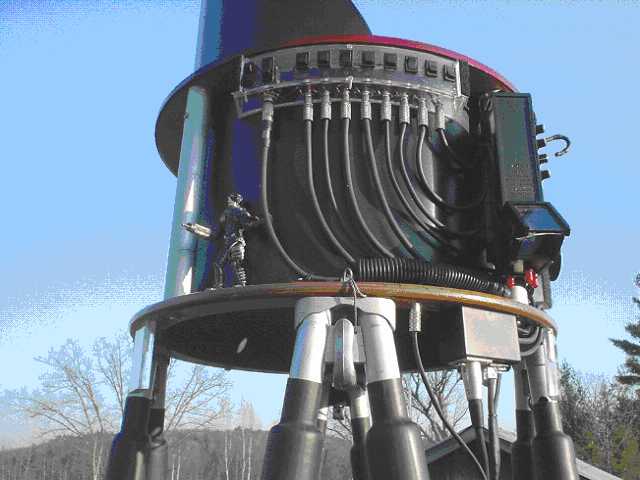 Photo of Upper Truss. Note Borg Figurine with RCA Jack on Arm. The RCA Jack Now
Sports An Indicator LED Showing That Power is Being Supplied to the Upper Truss
As Roger began adding material to the scope, he started to run into another problem - weight. Every ounce added to the upper
truss needs to be counterbalanced by six ounces on the rocker box. As a result, there are lots of counterweights on the scope.
In addition to the four sliding 2.5 lb weights on the rocker box’s exterior, there are several weights mounted below the mirror.
Eventually though, all that weight began to distort the rocker box, which was never meant to bear so much load. Roger shored
up the rocker box, and installed metal braces linked by turnbuckles. This insures that the box retains its square form. There
is a weight penalty for all this equipment, however. A stock 18” Obsession weighs around 110 lbs. The scope as you see it
weighs close to 210 lbs.
Photo of Upper Truss. Note Borg Figurine with RCA Jack on Arm. The RCA Jack Now
Sports An Indicator LED Showing That Power is Being Supplied to the Upper Truss
As Roger began adding material to the scope, he started to run into another problem - weight. Every ounce added to the upper
truss needs to be counterbalanced by six ounces on the rocker box. As a result, there are lots of counterweights on the scope.
In addition to the four sliding 2.5 lb weights on the rocker box’s exterior, there are several weights mounted below the mirror.
Eventually though, all that weight began to distort the rocker box, which was never meant to bear so much load. Roger shored
up the rocker box, and installed metal braces linked by turnbuckles. This insures that the box retains its square form. There
is a weight penalty for all this equipment, however. A stock 18” Obsession weighs around 110 lbs. The scope as you see it
weighs close to 210 lbs.
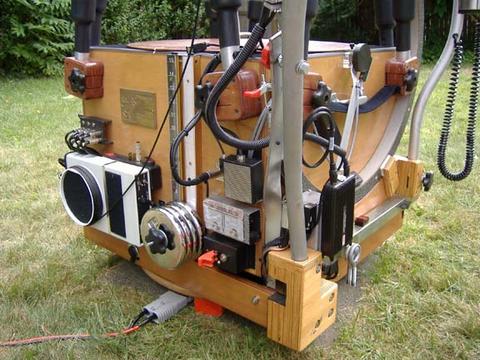 Photo of Rocker Box
One bugaboo with any large Dobsonian is collimation. Even with a laser collimator, the process usually requires two people,
or one person running back and forth from the primary to the focuser. To alleviate this, Greenwood purchased a small 40 mm
Maksutov Cassegrain spotting scope, which he mounted in one corner of the rocker box. The Mak is permanently aimed and
focused on the secondary mirror. This way, one person can sit at the back of the scope and do a quick, accurate collimation
without having to move back and forth.
Photo of Rocker Box
One bugaboo with any large Dobsonian is collimation. Even with a laser collimator, the process usually requires two people,
or one person running back and forth from the primary to the focuser. To alleviate this, Greenwood purchased a small 40 mm
Maksutov Cassegrain spotting scope, which he mounted in one corner of the rocker box. The Mak is permanently aimed and
focused on the secondary mirror. This way, one person can sit at the back of the scope and do a quick, accurate collimation
without having to move back and forth.
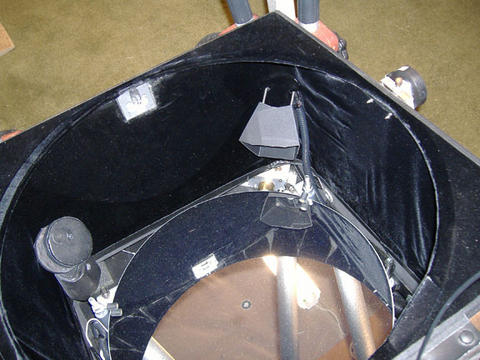 Barrier Fan Cools Mirror Without Directly Blowing Dust on Mirror Surface
Integral to the telescope is the 2.8 Ghz laptop computer running Starry Night Pro Plus. Greenwood “cleared out” most the other
resident programs in the PC, so that SNP can run as efficiently as possible. It’s mounted on a metal brace which curves away
from the telescope and sits inside an acrylic dew shield at waist level. The computer uses a wireless mouse and has USB red
lamps to illuminate the keyboard. Greenwood does not care for the “red screen” feature on SNP, so he designed a red plastic
shield that covers the screen. The computer has built-in wifi, so users can surf the web, check on cloud cover conditions,
or check email while in the field.
Barrier Fan Cools Mirror Without Directly Blowing Dust on Mirror Surface
Integral to the telescope is the 2.8 Ghz laptop computer running Starry Night Pro Plus. Greenwood “cleared out” most the other
resident programs in the PC, so that SNP can run as efficiently as possible. It’s mounted on a metal brace which curves away
from the telescope and sits inside an acrylic dew shield at waist level. The computer uses a wireless mouse and has USB red
lamps to illuminate the keyboard. Greenwood does not care for the “red screen” feature on SNP, so he designed a red plastic
shield that covers the screen. The computer has built-in wifi, so users can surf the web, check on cloud cover conditions,
or check email while in the field.
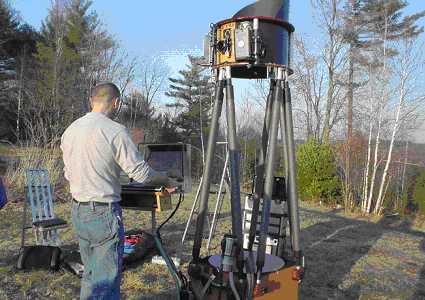 Booting Up The Laptop
The computer synchs with the Argo Navis unit and offers a wealth of information, as well as some conveniences. Want
to see all the galaxies in Virgo brighter than 10th magnitude? Just filter your search results and have the scope
slew to them. Want to see the exact field of view in your eyepiece? Superimpose the custom FOV indicator onto the
map. If someone starts asking for data on a particular object, one click brings up a detailed list of information.
During our club’s 2006 Messier Marathon, I was hanging around the scope and noticed several “blips” moving across the screen
at various times. It turns out that the computer knows satellite data, and plots their positions in real time on the screen.
This led to our playing a game, which might be called “catch that satellite.”
All of these electronic devices require power, of course. Power is supplied via a 110 amp hour deep cycle marine battery
mounted in a rolling tool chest. The tool chest features meters that measure voltage and amperes, so the user can keep track
of how much power is left. The top drawer of the tool chest functions as the eyepiece case. Greenwood is fond of binoviewers,
so the case carries a Denkmeier bino view unit, two 24 mm Panoptics, two 13 mm Naglers, and a 31 mm Nagler with a Paracorr
attached.
Booting Up The Laptop
The computer synchs with the Argo Navis unit and offers a wealth of information, as well as some conveniences. Want
to see all the galaxies in Virgo brighter than 10th magnitude? Just filter your search results and have the scope
slew to them. Want to see the exact field of view in your eyepiece? Superimpose the custom FOV indicator onto the
map. If someone starts asking for data on a particular object, one click brings up a detailed list of information.
During our club’s 2006 Messier Marathon, I was hanging around the scope and noticed several “blips” moving across the screen
at various times. It turns out that the computer knows satellite data, and plots their positions in real time on the screen.
This led to our playing a game, which might be called “catch that satellite.”
All of these electronic devices require power, of course. Power is supplied via a 110 amp hour deep cycle marine battery
mounted in a rolling tool chest. The tool chest features meters that measure voltage and amperes, so the user can keep track
of how much power is left. The top drawer of the tool chest functions as the eyepiece case. Greenwood is fond of binoviewers,
so the case carries a Denkmeier bino view unit, two 24 mm Panoptics, two 13 mm Naglers, and a 31 mm Nagler with a Paracorr
attached.
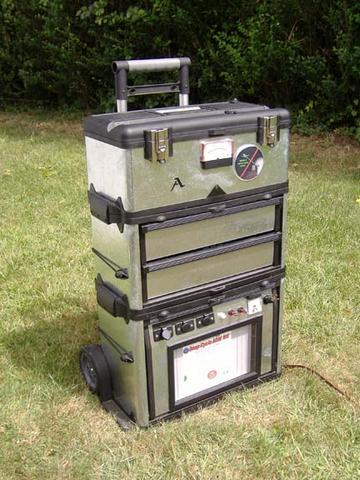 The Power Supply Unit. The Battery Resides in the Lower Compartment.
Upper Compartment Contains Eyepieces and Binoviewer
All the eyepieces (and the binoviewer) are heated while in the case to ward off dew, and red light rope around the inside
allows the observer to see what’s inside the box. Greenwood reports that dew is never a problem with his eyepieces.
Roger says even with all the electrical devices operating, the current draw never exceeds 11 amps. Even under these extreme
conditions, the battery should easily last all night. The power supply is tethered to the main scope using 40 A house
wiring cable. Greenwood says he never expects the scope to draw this much power, but due to the length of the cable, he
wanted the least amount of electrical resistance in the wiring. The thick cable also withstands abuse, including accidental
tripping by wayward feet in the dark. One unexpected problem he had was electrical noise. Some of the electronic equipment
functioned intermittently. He eventually traced the problem to ground loops. After instituting a careful grounding system
in the scope, the electrical noise went away.
The Power Supply Unit. The Battery Resides in the Lower Compartment.
Upper Compartment Contains Eyepieces and Binoviewer
All the eyepieces (and the binoviewer) are heated while in the case to ward off dew, and red light rope around the inside
allows the observer to see what’s inside the box. Greenwood reports that dew is never a problem with his eyepieces.
Roger says even with all the electrical devices operating, the current draw never exceeds 11 amps. Even under these extreme
conditions, the battery should easily last all night. The power supply is tethered to the main scope using 40 A house
wiring cable. Greenwood says he never expects the scope to draw this much power, but due to the length of the cable, he
wanted the least amount of electrical resistance in the wiring. The thick cable also withstands abuse, including accidental
tripping by wayward feet in the dark. One unexpected problem he had was electrical noise. Some of the electronic equipment
functioned intermittently. He eventually traced the problem to ground loops. After instituting a careful grounding system
in the scope, the electrical noise went away.
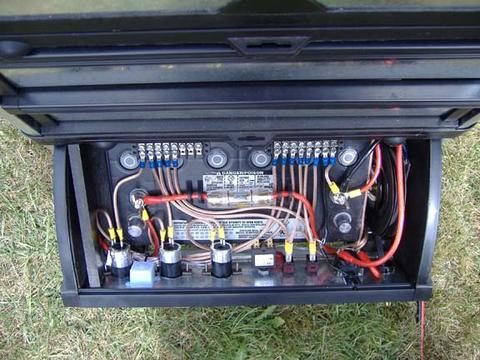 110A Hour Marine Cycle Battery
All in all, the scope takes about 20-30 minutes to assemble, depending on how far the parts need to be moved. Although
Greenwood usually transports the scope in a minivan, he says that with creative packing, he can actually get all the parts
inside his Honda Civic for long trips where fuel economy is paramount. Seeing the scope magically appear from a tiny
Honda Civic alone is worth the trip to the observing field!
Greenwood says he has few regrets about modifying his stock telescope. The biggest problem, other than the increased weight
and setup time, is that strangers are constantly asking him to explain the features of the telescope to them. He often has
little time for observing. I suggested to him that he mount a second laptop on the other side of the scope with a continuously
running Powerpoint presentation, explaining the features of the scope. When he heard this, Roger glanced up dreamily at the
sky and thought about it.
One observer remarked that the scope does everything but make coffee. The telescope does not make coffee, but it will keep
it warm for you. Mounted on the side of the scope is a cup holder with a heated, insulated cup. The observer can dial in
the desired temperature of their beverage, knowing that it will always be ready for them.
110A Hour Marine Cycle Battery
All in all, the scope takes about 20-30 minutes to assemble, depending on how far the parts need to be moved. Although
Greenwood usually transports the scope in a minivan, he says that with creative packing, he can actually get all the parts
inside his Honda Civic for long trips where fuel economy is paramount. Seeing the scope magically appear from a tiny
Honda Civic alone is worth the trip to the observing field!
Greenwood says he has few regrets about modifying his stock telescope. The biggest problem, other than the increased weight
and setup time, is that strangers are constantly asking him to explain the features of the telescope to them. He often has
little time for observing. I suggested to him that he mount a second laptop on the other side of the scope with a continuously
running Powerpoint presentation, explaining the features of the scope. When he heard this, Roger glanced up dreamily at the
sky and thought about it.
One observer remarked that the scope does everything but make coffee. The telescope does not make coffee, but it will keep
it warm for you. Mounted on the side of the scope is a cup holder with a heated, insulated cup. The observer can dial in
the desired temperature of their beverage, knowing that it will always be ready for them.
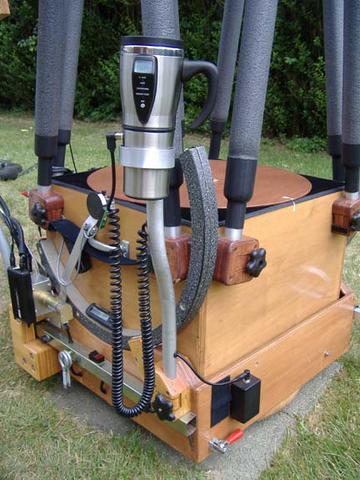 Insulated Coffee Cup With Digitally Regulated Temperature
In the field, the scope performs flawlessly. It turns your observing session into a learning experience. The Argo Navis
unit acquires objects easily, the software gives you more information than you’d find in any book, and the system does not
suffer from observer “fatigue” – it’s always ready to do what it’s asked. In fact, as the night wears on, more and more
people tend to gather around the “Borg” scope. As observers get tired, they’re more than content to let the telescope do
the work for them. And if the skies cloud over, the PC is there to provide information and entertainment.
As for the future, Roger says there are several items already on the drawing boards. He’s thinking of motorizing the wheels,
perhaps with remote control. Also, he’s working on installing video feed from a small refractor mounted on the rocker box.
The laptop(s) would show what the scope is pointed at. Going wireless with the controls is a real possibility, and the
second PC (mentioned earlier) could come in handy. An audio system would eliminate the need to stand near the PC
to read information. Finally, he looking at upgrading the pushbuttons to joysticks.
Whatever the future holds, you can certain that the scope has not been finished being assimilated!
Insulated Coffee Cup With Digitally Regulated Temperature
In the field, the scope performs flawlessly. It turns your observing session into a learning experience. The Argo Navis
unit acquires objects easily, the software gives you more information than you’d find in any book, and the system does not
suffer from observer “fatigue” – it’s always ready to do what it’s asked. In fact, as the night wears on, more and more
people tend to gather around the “Borg” scope. As observers get tired, they’re more than content to let the telescope do
the work for them. And if the skies cloud over, the PC is there to provide information and entertainment.
As for the future, Roger says there are several items already on the drawing boards. He’s thinking of motorizing the wheels,
perhaps with remote control. Also, he’s working on installing video feed from a small refractor mounted on the rocker box.
The laptop(s) would show what the scope is pointed at. Going wireless with the controls is a real possibility, and the
second PC (mentioned earlier) could come in handy. An audio system would eliminate the need to stand near the PC
to read information. Finally, he looking at upgrading the pushbuttons to joysticks.
Whatever the future holds, you can certain that the scope has not been finished being assimilated!
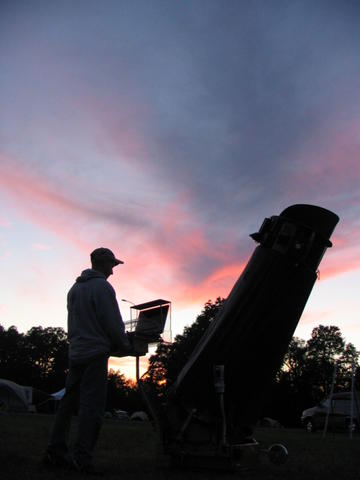
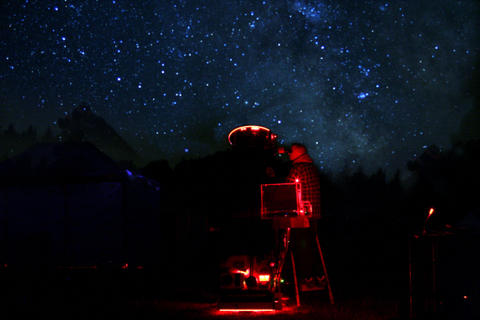 Under Dark Skies the at Black Forest Star Party
Roger can be reached at: Astrocrumb Online
Under Dark Skies the at Black Forest Star Party
Roger can be reached at: Astrocrumb Online
Back to Home Page
 What's A Borg Doing On a Telescope? Read On!
What's A Borg Doing On a Telescope? Read On!
 Photo of Stock 18" Obsession
Photo of Stock 18" Obsession Photo of Modified Telescope
Photo of Modified Telescope Photo of Upper Truss. Note Borg Figurine with RCA Jack on Arm. The RCA Jack Now
Sports An Indicator LED Showing That Power is Being Supplied to the Upper Truss
Photo of Upper Truss. Note Borg Figurine with RCA Jack on Arm. The RCA Jack Now
Sports An Indicator LED Showing That Power is Being Supplied to the Upper Truss Photo of Rocker Box
Photo of Rocker Box Barrier Fan Cools Mirror Without Directly Blowing Dust on Mirror Surface
Barrier Fan Cools Mirror Without Directly Blowing Dust on Mirror Surface Booting Up The Laptop
Booting Up The Laptop The Power Supply Unit. The Battery Resides in the Lower Compartment.
Upper Compartment Contains Eyepieces and Binoviewer
The Power Supply Unit. The Battery Resides in the Lower Compartment.
Upper Compartment Contains Eyepieces and Binoviewer 110A Hour Marine Cycle Battery
110A Hour Marine Cycle Battery Insulated Coffee Cup With Digitally Regulated Temperature
Insulated Coffee Cup With Digitally Regulated Temperature
 Under Dark Skies the at Black Forest Star Party
Under Dark Skies the at Black Forest Star Party